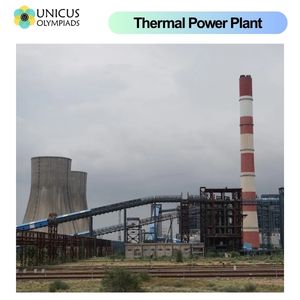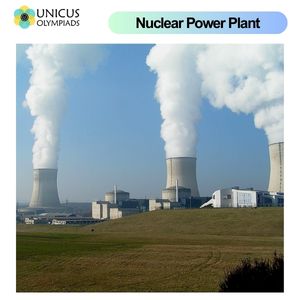

Thermal and nuclear power plants are two of the most significant sources of electricity generation worldwide. While both produce electricity using heat, the sources of heat and their environmental impacts are quite different. Thermal power plants typically burn fossil fuels such as coal, oil, or natural gas, while nuclear power plants use nuclear reactions to generate heat. This distinction leads to differences in the resources used, the environmental impact, and the long-term sustainability of each energy source. This article explores how thermal and nuclear plants differ in terms of their resource use and environmental impact, providing examples to highlight their strengths and challenges.
Thermal power plants, also known as conventional power plants, generate electricity by converting heat energy, typically produced from burning fossil fuels, into electrical energy. The most common types of thermal power plants are coal-fired, natural gas, and oil-fired plants. The process generally involves the combustion of fuel to produce steam, which drives a turbine connected to a generator that produces electricity.

Thermal power plants use heat from burning fossil fuels to produce steam, which then drives a turbine to generate electricity. The fuel is burned in a furnace or boiler, and the heat produced is transferred to water, turning it into steam. The steam flows through turbines, which rotate to generate power. The process is highly efficient in converting heat energy into electrical energy but depends on the availability and combustion of fossil fuels.
Nuclear power plants use nuclear reactions to generate heat, which is then used to produce electricity. The process relies on the fission of heavy atoms like uranium or plutonium, which releases a significant amount of heat. This heat is used to produce steam, which drives turbines connected to generators to produce electricity. Nuclear power plants are distinct from thermal plants in that they use nuclear fuel rather than fossil fuels to generate heat.

In a nuclear power plant, uranium-235 or plutonium-239 atoms are split in a process called nuclear fission. When these atoms are split, they release a large amount of energy in the form of heat. This heat is used to produce steam, which drives turbines to generate electricity. Unlike thermal power plants, nuclear plants do not burn fossil fuels, and therefore, do not produce carbon dioxide (CO2) emissions during operation. However, nuclear power does present unique challenges, particularly in terms of waste management and safety concerns.
The primary difference between thermal and nuclear power plants is the type of fuel used. Thermal power plants rely on fossil fuels, such as coal, oil, and natural gas, while nuclear plants use uranium or plutonium as their fuel source. This distinction has significant implications for the resources required, the sustainability of the energy produced, and the environmental impact of each type of plant.
Thermal power plants rely heavily on fossil fuels, which are finite resources. Coal, natural gas, and oil are extracted from the Earth through mining, drilling, and other methods. These resources are non-renewable, meaning they will eventually be depleted, and their extraction can have environmental consequences. Fossil fuels are also the largest contributors to greenhouse gas emissions, particularly carbon dioxide (CO2), which is a major driver of climate change.
Nuclear power plants use uranium or plutonium as fuel. While these materials are not renewable in the same way as fossil fuels, they are much more abundant than fossil fuels and can be extracted through mining. Nuclear power also generates a large amount of energy from a relatively small amount of fuel, making it highly efficient in terms of resource use. However, the mining, processing, and transport of uranium come with their own environmental and safety concerns.
One of the most significant differences between thermal and nuclear power plants is their environmental impact. While both types of plants produce heat to generate electricity, the byproducts of their operations vary greatly. Thermal power plants, particularly those that burn fossil fuels, release large amounts of greenhouse gases and pollutants, while nuclear plants produce radioactive waste, which presents its own unique environmental challenges.
Thermal power plants are a major source of air pollution and greenhouse gas emissions. Burning coal, oil, or natural gas releases carbon dioxide (CO2), sulfur dioxide (SO2), nitrogen oxides (NOx), and particulate matter into the atmosphere. These emissions contribute to climate change, acid rain, smog, and respiratory diseases.
Nuclear power plants, on the other hand, do not emit greenhouse gases during operation, making them an attractive option for reducing CO2 emissions. However, they create radioactive waste that must be securely stored for thousands of years. Additionally, nuclear plants require significant amounts of water for cooling, which can also impact local ecosystems. The risk of accidents, such as the Chernobyl disaster in 1986 and the Fukushima Daiichi accident in 2011, remains a significant concern for nuclear energy.
Safety is a critical consideration in both thermal and nuclear power generation, but the risks associated with each type of plant differ. Thermal power plants, while generally considered safer, can have serious environmental and health consequences due to their emissions and resource use. Nuclear power plants, though less polluting in terms of greenhouse gas emissions, come with the potential for catastrophic accidents and long-term waste disposal issues.
The primary safety concerns with thermal power plants are related to their environmental and health impacts. The burning of fossil fuels in thermal plants can lead to air pollution and health problems such as asthma, respiratory diseases, and cardiovascular issues in surrounding populations. Coal mining, in particular, can also lead to accidents, including explosions and cave-ins.
While nuclear power plants do not produce harmful air pollutants, their potential for catastrophic accidents makes them inherently risky. The radioactive materials used in nuclear reactors can be dangerous if not properly contained. The management of nuclear waste is another significant challenge, as it remains hazardous for thousands of years.